|
Raymond Mays - man
about town
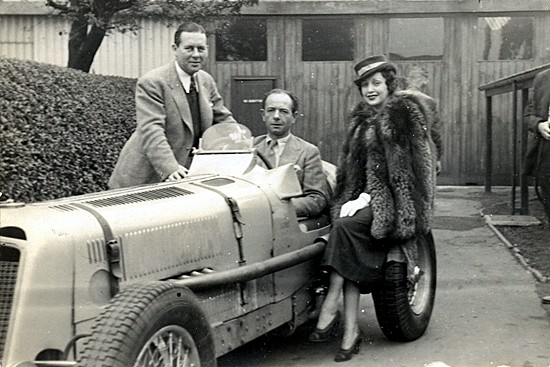
Raymond at the wheel with radio stars Bebe Daniels and Ben Lyon who
were
visiting Eastgate House in 1938
Raymond Mays was thrust into the world of
business as head of the family firm of skin dealers and fertiliser
manufacturers and as the founder of ERA and BRM although he was always
more at home in the front row of the stalls at Daley's Theatre in London rather than
sitting round the boardroom table running a company.
He acquired a love of the theatre as a young man about town which remained
with him until he died and enjoyed the close friendship of many stars of
the day who he frequently met in London and visited him at his home in
Bourne for weekend parties. Even at the age of 20, his first racing car, a
Bugatti Brescia, was called Cordon Rouge after the famous brand of
champagne, and a second Bugatti followed, this time named Cordon Bleu
after the brandy, an indication of his love for the high life.
Raymond was born at Eastgate House on 1st August 1899 and after a spell at
Oundle School he went to the Guards Officers Training Establishment at
Bushy Hall where he was commissioned as a subaltern in the Grenadier
Guards in May 1918 and sent to Chelsea Barracks in London, a posting that
enabled him pursue his stylish living and predilection for theatrical
musical comedies. The following October, he was posted to France and after
the Armistice was signed on November 11th, he went to Germany with the
army of occupation but he did not take to military life and returned to
Bourne the following year after resigning his commission.
His only other time in uniform was on 1st March 1939 when, with another
world war looming, he was sworn in as a special constable for
Lincolnshire. By this time he was 40 years old and unlikely to have been
called up for military service although little is known about his duties
after that or whether he actually went out on patrol in the streets of
Bourne or assisted at public functions.
|
SPECIAL CONSTABLE
MAYS
Raymond signed on with the County of
Lincolnshire Police on 1st March 1939 and according to his warrant
card, became Special Constable No 269. |
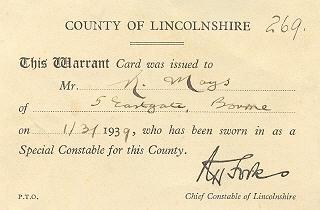 |
Raymond was obviously stage struck and
once said that if he had not been able to motor race, he would have loved
to have pursued a career in the London theatre. He also unashamedly admitted that he had fallen for the musical comedy star,
Winifred Barnes, while serving with the Grenadier Guards at Chelsea
Barracks. She was then appearing in The Happy Day at Daly's Theatre and
was extremely popular with the young officers. "Night after night I gazed
at her from the front row of the stalls and decided I must meet her", said
Raymond. "I called at her Eaton Square house but she was out and
unfortunately another opportunity did not come along." But there were
to be other infatuations that turned into lasting friendships.
|
A STAGE INFATUATION
Raymond was so taken with the beautiful musical
comedy star Winifred Barnes that he found out her address and went
to her house in Eaton Square, London, hoping that she would see him
but unfortunately, she was out and he never did manage to meet her. |
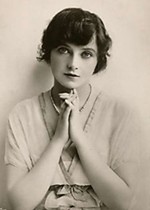 |
After resigning his commission, Raymond went up to Cambridge in 1919 to
read engineering at
Christ's College but still managed many trips to the London theatres and
to pursue his love of racing through the Cambridge University Automobile
Club. But times were bad in the family business and Raymond left Cambridge
without a degree, returning to Bourne to join the family firm although
motoring remained his main interest. His father, Thomas Mays, died in 1934, and his mother Annie remained his
hostess at Eastgate House, always offering support and encouragement,
organising the hospitality, arranging rooms and meals for guests attending
his lavish parties which frequently included businessmen, famous
personalities from the world of motor sport as well as the stars of stage
and radio, and although handicapped by arthritis in her later years, she
presided over Eastgate House from her bedroom until she died there in
1973, aged 97.
Raymond also took an active part in amateur dramatics in Bourne for a
spell, appearing in a production of The Quaker Girl presented by the
Bourne Amateur Operatic Society at the Corn Exchange in 1930 when he was
on stage with two of the society's stalwarts, Win Hassock and Kath Hinson
who remembered in later years: "He could neither act nor sing that well
but my goodness he certainly looked good on stage." Ballroom dancing was another
matter and among his hundreds of motor racing trophies was a silver cup
for winning a competition at Skegness. He had already gained a great deal
of experience on the floor by joining several dancing clubs while at
Cambridge University and so the competition at the seaside resort's Casino
Ballroom during a family outing presented a challenge which he and his
cousin, Nona Agnew, accepted with enthusiasm and they won first place,
even though hundreds of couples were taking part.
Among those who also made the journey from
London's West End was
José Collins, star of the musical The
Maid of the Mountains at Daly's Theatre, one of Raymond's favourites which he saw again and again. "I
first went with my parents when I was a schoolboy and I was captivated",
he recalled later. "The music and the scenery thrilled me but most of all
José Collins. Her magnificent voice,
her black hair and the intensity of her acting held me spellbound. I
longed to go and make myself known to her and determined to do so one day. In the years that followed, while at Cambridge and in
the army, I saw it 84 times, always with José Collins, and she later
became a very good friend. I remained a terrific admirer."
|
A THEATRICAL MEMENTO
In 1937, Raymond sailed for South Africa to
compete in the Rand Grand Prix at Johannesburg and José
Collins went aboard the City of London before it sailed for Cape
Town to present him with a talisman, a little black touchwood doll
with the letters ERA across its blue-clad midriff. He finished
seventh but treasured the lucky charm for the rest of his life. |
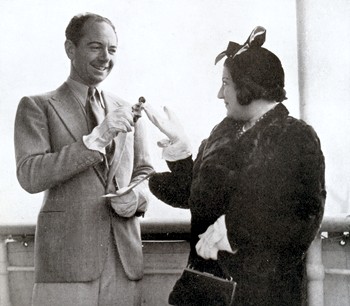 |
In 1935, Raymond met Ivor Novello who at
that time was the darling of London's West End theatre where several of
his musical comedies enjoyed a hugely popular success. Glamorous Night at
the Drury Lane Theatre was among the most famous and the first to star
Mary Ellis, another favourite with Raymond, who saw the show and became
firm friends with both her and the composer who also visited Eastgate
House on several occasions.
Mary Ellis was particularly popular in Novello's production of The Dancing
Years. "I first went to see this show just before the war", said Raymond.
"I knew and admired Ivor and often went to see it at Drury Lane. During
the war years my mother used to send Mary eggs because she couldn't get
any. My favourite song from the show was I can give you the starlight and
the producers would sometimes cut this particular number from the show but
whenever I went to see it, I would send a little note round to the stage
door to say that I was in the audience and would she sing it and she
always did."
One of his favourite pieces of music was A Stranger in Paradise from the
London stage production of Kismet which he saw several times when it was
sung by Richard Kiley and Doretta Morrow. "A beautiful song that I never
tired of hearing", said Raymond. "I loved the melody and the words and it
was played by orchestras around the world and if they did not, I always
used to ask them to."
|
GLAMOROUS VISITORS TO EASTGATE HOUSE |
|
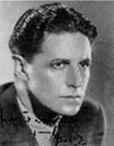 |
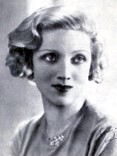 |
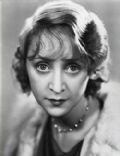 |
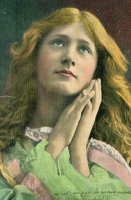 |
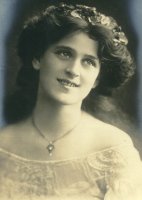 |
Other guests included Novello himself, Binnie Hale, Phyllis and Zena Dare,
Norma Shearer and Bebe Daniels and Ben Lyon, two American friends who were
to achieve fame on wartime radio in Britain with their patriotic shows Hi
Gang and Life with the Lyons.
Raymond never married and in his final years, became a solitary figure,
often seen walking the streets of Bourne alone with his dog, and receiving
only occasional visitors, confiding in one of them with some
disappointment: “You know, I have done absolutely nothing for Bourne.”
He died on 6th January 1980 with debts of £150,000, his house heavily
mortgaged and most of the valuable contents already sold. These included a
series of nine original water colour paintings by the motoring artist Gordon
Crosby, showing Raymond in action on the track, that had been bought by a
Swiss count with the proviso that they would stay on the walls of Eastgate
House until Raymond's death and when this eventually occurred, they were
collected by the owner and shipped to his home in Switzerland.
|
THE CROSBY PAINTINGS
Frederick Gordon Crosby (1885-1943) specialised
in painting motor racing pictures, particularly Grand Pix events. He
was a former draughtsman with the Daimler company and although he
had no formal training as an artist left a legacy of some 300-400
paintings. This one in charcoal and watercolours and measuring 55 X
53 cm shows Raymond Mays' ERA contesting the British Empire Trophy
at Donington in 1937. |
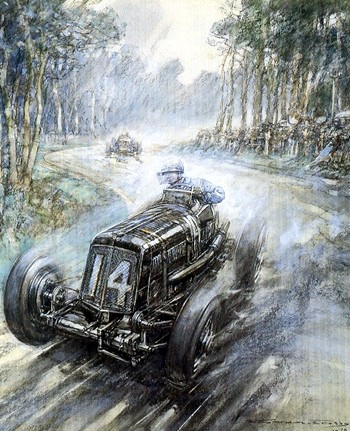 |
The house
itself and what was left of the family estate were sold and the money
raised went to help pay his debts. His CBE, awarded for services to motor
sport in 1978, was offered for sale after his death in March 1994 when it
fetched just under £400 at Sotheby’s auction rooms in London.
His funeral was held at the Abbey Church followed by a private cremation
at Grantham and so there is no headstone in the town cemetery where his
father and other ancestors are buried. But in the summer of 2002, a new
perimeter road on the Elsea Park estate was named the Raymond Mays Way in
his honour and the following year, in November 2003, a £10,000 motor
racing memorial was unveiled on a grassy patch in South Road to remember
his achievements while the Raymond Mays Memorial Room at the nearby
Heritage Centre contains a wealth of material in photographs and artefacts
collected by the Civic Society recording his life and career.
|
PHOTO GALLERY |
|
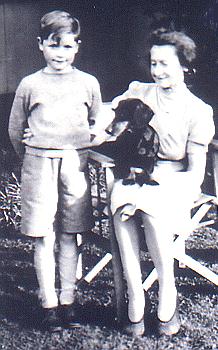 |
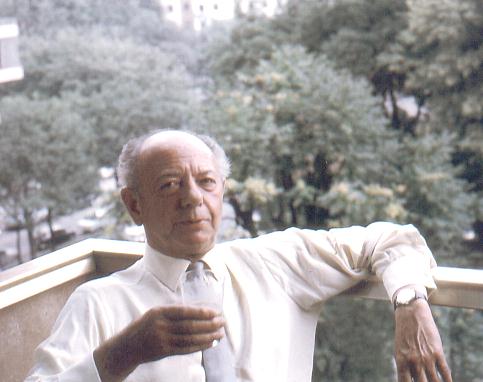 |
|
Raymond with his mother, pictured in
the garden of their home at Eastgate House when he was a boy, and
the bon viveur of later life, enjoying a drink in the
sunshine on the verandah of a holiday flat in one of the
Mediterranean resorts. |
|
A RARE PUBLIC
APPEARANCE |
|
This is one of
the last photographs taken of Raymond Mays and one that marked a
rare public appearance in Bourne. On 7th June 1977, he was persuaded
to present the prizes during the town's festivities to mark the
Queen's Silver Jubilee and he is seen here handing over certificates
for the best kept float in the parade through the town to children
from the village of Twenty. He was then 77.
In the picture: Left to right, Raymond Mays, Sir
Simon Benton Jones (High Sheriff of Lincolnshire), Lady Benton Jones
and Councillor Don Fisher. |
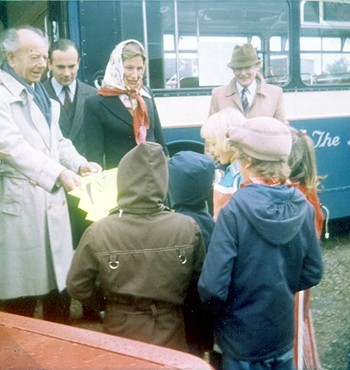 |
|
ON STAGE WITH THE AMATEURS |
|
Raymond cut a dashing figure in his role as
a naval officer in the 1930 production of The Quaker Girl presented
at the Corn Exchange by the Bourne Amateur Operatic Society although
he never became a permanent member of the company. These
studio photographs were taken to publicise the show by Florence Redshaw,
daughter of William Redshaw, probably the town's leading
photographer whose work survives as a reminder of the way things
were. |
|
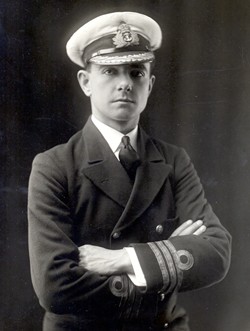 |
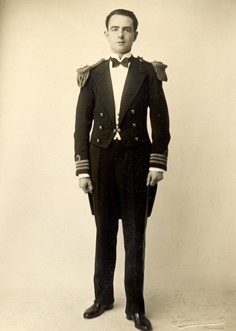 |
|
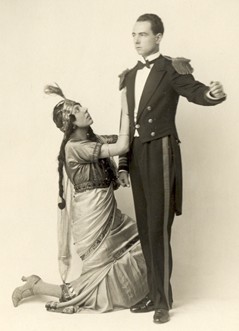 |
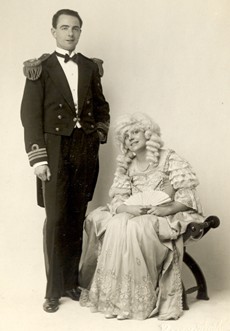 |
See also
Desert Island Discs The
Theatre
Return to
Raymond Mays

Go to:
Main Index Villages
Index
|
















